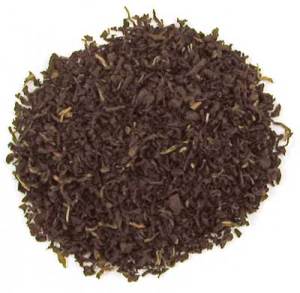Assam teas have two basic quality designations: CTC and Orthodox. There are further distinctions from there, but these two are the starting points. I already explored CTC. Now it’s time to look at what “Orthodox Assam” tea is.

Generally, Orthodox Assams are higher quality, less likely to be bitter, and contain more subtle and multi-layered flavors than CTC Assams. But that’s not the whole story. For one thing, they are usually harvested by hand to get intact, whole leaves — small, young tea leaves plucked from the tips of the tea bush. For another, contrary to what many say, Orthodox Assams are not processed entirely by hand. Once harvested, they go through several processes which may be done by hand or machine.
Processing of Orthodox Assams:
- Withering — Done on long metal troughs in a shaded area for about 14-20 hours. The tea leaves are spread out, and as moisture evaporates from them, they become limp and pliable, allowing them to be rolled without damage.
- Rolling — Done by hand for the highest grades and machine for the lower grades (usually, large-scale production). The wilted leaves are pressed by rollers while being rotated around each other to release chemicals stored in the leaf cells and beginning the oxidation process by exposing them to the air.
- Oxidation — The tea leaves are laid out for about 2-4 hours in a humidity- and temperature-controlled room, where the air reacts with the chemicals released during rolling and turns the leaves from green to reddish-brown and then black. If the leaves are oxidized too long, the tea will be strong and lose its subtlety. If too short, the complex flavors will not fully develop.
- Firing — This step halts oxidation and completes the drying of the tea leaves. They move on a conveyor belt through a charcoal fire heater at around 220-250˚ F for 20-40 minutes and then are sorted by leaf grade by a machine that shakes them over varying gauges of mesh that sifts by size. The largest pieces may be hand-sorted to assure consistent size and therefore steeping time. Young, whole leaf teas are generally higher priced than the broken leaf grade.
Grades of Orthodox Assams:
- Golden Tip — Highest grade comprised of mainly the best quality tips from the stems of the tea bush (Camellia Sinensis).
- FTGFOP1 (Finest Tippy Golden Flowery Orange Pekoe First Grade) — The finest top-grade production with an abundance of tips.
- TGFOP1 (Tippy Golden Flowery Orange Pekoe First Grade) and TGFOP (Tippy Golden Flowery Orange Pekoe) — The main grades of fine quality Assam teas.
- FTGBOP (Fancy Tippy Golden Broken Orange Pekoe) — A step down from the above grades.
The main part of the above grades is the “GFOP” and “GBOP” where the second letter in each is the key. Full leaf versus broken leaf can make a difference, with the latter releasing more tannin into the liquid and therefore more likely to be bitter. If you are sensitive to tannin, spend a bit extra for the GFOP Orthodox Assam.
By the way, you won’t always see the word “Orthodox” on the tea label. But if you see one of the above grade labels, it will most likely be an Orthodox Assam. Enjoy!
Visit A.C.’s blog to learn more about the fascinating world of tea!



Leave a comment